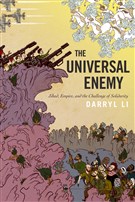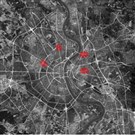In recent months, more and more quarters of respectable opinion have sounded the alarm that at some undefined point in the future, partition of Israel/Palestine along the 1967 lines will no longer be “feasible.” Yet any ensuing fights over the accuracy – or even the public acceptability – of such announcements miss how far ahead the Zionist right is on these questions. Unwedded to any pieties about “moderation” or the “two-state solution,” some Zionists have floated the idea of formally annexing the West Bank and extending citizenship to Palestinians – but with the massive asterisk of excluding the 1.7 million Palestinians in the Gaza Strip in order to forestall a clear indigenous demographic majority.
While one can ridicule this proposal as a non-starter, it is a helpful reminder of the dangers lurking ahead for the Palestinian national movement in the wake of Israel’s onslaught against the Gaza Strip last month. The cease-fire agreement that ended the latest conflagration has been seen by both supporters and critics as a political victory for Hamas. Yet historically, greater autonomy for Palestinians in Gaza – be it under Fatah after the first Intifada or Hamas after the second – has come at the expense of broader solidarity. There is again a danger that Israel will exploit short-term Palestinian gains on the ground in order to further deepen the political disconnect between the Gaza Strip and the rest of the Palestinian people. If such trends continue, then the proposal above of an open apartheid regime with a Jewish majority made possible by removing Gaza from the demographic equation may not be such a remote possibility after all.
Demanding Subjects
Since 2005, Israel has developed an unusual, and perhaps unprecedented, experiment in colonial management in the Gaza Strip: it has sought to isolate Palestinians there from the outside world, render them utterly dependent on external benevolence, and absolve Israel of responsibility toward them, all at the same time. The problem with all experiments – especially when the subjects are not chemical compounds or animals but human beings with claims to freedom and dignity, which is to say that they are demanding subjects in all senses of the phrase – is that they can sometimes blow up in your face, quite literally. In order to better understand the dynamics at work, let us turn to the South African example by way of contrast.
When Ariel Sharon first floated the disengagement plan in 2004, the Israeli political columnist Akiva Eldar noted that it was “amazingly similar” to the Bantustan scheme, in which apartheid South Africa concentrated much of the native population in a series of disconnected, landlocked enclaves. The hope was that the illusion of independence or autonomy for black South Africans living in these “homelands” would placate international criticism of the apartheid regime.
Israel strived to succeed where South Africa failed, and two factors weighed in its favor. First, the Bantustans were designed to warehouse natives commuting to work in the rest of the country. In contrast, Israel’s unilateral disengagement spelled the end of Israel’s reliance on labor from Gaza, largely curtailing the possibility for meaningful civil disobedience. It is much harder to have a “Palestinian Gandhi,” after all, among a population who you do not ask to work or pay taxes. Second, South Africa tried and failed to convince the international community to recognize the Bantustans as independent states, which would have entailed depriving of millions of people of South African citizenship. In contrast, the international community has long considered the West Bank and Gaza as occupied territories, meaning Israel cannot legally claim them as its own but by the same token need not grant the inhabitants citizenship in the first place.
Despite these undeniable advantages over its South African counterpart (to say nothing of a less lopsided demographic distribution vis-à-vis natives and a Very Special relationship with the United States), Israel’s control over the Gaza Strip faces the same basic problem that plagued the Bantustan project: a shift to indirect control does not end resistance, it merely reshapes its opportunities and constraints. The “native” chiefs who ruled the Bantustans in collaboration with the apartheid regime faced considerable opposition from their own populations. As long as the Bantustans were a vehicle for the immiseration and exploitation of natives, it was inevitable that chiefs would be branded as collaborators and forced either to switch sides or to go down with their patrons. In the late 1980s, a group of chiefs in South African Bantustans, sensing the shift in prevailing winds, broke from the apartheid regime and aligned with the African National Congress. In 1988, South African troops had to invade Bophuthatswana–the second-largest of the four “independent” homelands—in order to reverse a coup against Pretoria’s local surrogate.
Reckless Abandon
As in South Africa, Israel has allowed some natives to manage some of their own affairs as a way to maintain the illusion that Palestinians have been making progress toward independence and sovereignty. In the Gaza Strip, however, this process of controlled abandonment has been no less messy than the Bantustan experiment. The near-total isolation imposed on the Gaza Strip entailed a significant gamble for Israel: it could retain overwhelming power in dictating the conditions of everyday life – including how much electricity and food Palestinians could consume – but it gave up significant leverage in influencing political developments on the ground. Although this latest stage of colonial rule left the structure of native administration – the “Palestinian National Authority” (PNA) – largely intact, Israel could no longer control the selection of its native chiefs. Using ground forces to prop up Fatah against its rival Hamas was no longer an option.
Nevertheless, the Hamas takeover of PNA institutions – electorally in 2006, practically in 2007 – seemed to Israel a price worth paying. Hamas faces many of the same constraints on its rule as its predecessors did, including dependence on Israel for electricity, fuel, even cash for the economy (armored trucks continue to deliver shekels to Gaza for use in banks that Israel can then bomb in turn). Meanwhile Hamas’s armed capabilities remain far less lethal than the ambushes and infiltrations that afflicted Israeli military bases and colonies within the Gaza Strip prior to disengagement. And most importantly, Hamas served as a convenient “radical” bogeyman to justify the lack of any movement on the diplomatic track. This reconfigured space paved the way for displays of overt violence unprecedented in the history of the occupation. Declaring Gaza a “hostile entity” with an illusion of parity, Israel could accordingly employ airpower with even greater abandon than before, hoping that spectacular and indiscriminate bombardment (infamously shrugged off as “mowing the lawn”) would cow the civilian population.
Yet the latest aggression, Operation Pillar of Cloud, demonstrated the limits of Israel’s experiment in indirect control and isolation. First, Palestinians now managed to make some use of the post-2005 contours for resistance. By moving from street patrols and fortifications to aerial bombing over the past two decades, Israel had deprived Palestinians of any readily accessible targets. This had rendered both civil disobedience and traditional guerrilla warfare unavailing, hence a shift to manufacturing projectiles. If Gaza was the first place for Israel to test out a strategy of long-distance control, then it should not be a surprise that Gaza was the first native reserve in Palestine to develop some form of long-distance military capability, however limited. As mentioned above, this shift seemed to have worked to Israel’s overall benefit until recently, since the rockets were largely ineffective in imposing tactical losses or political costs. But now that Hamas has demonstrated its ability to threaten Tel Aviv and Jerusalem despite sustained bombardment, the calculus for military action has been altered. Startled, Israel now needs time to reconsider options in light of its own domestic elections and the shifting regional environment. Hence Netanyahu’s precipitous acceptance of a ceasefire.
Second, Israel’s resort to indiscriminate bombing as a way to intimidate the population paradoxically drove the people and Hamas to stand together in a way that even the more punishing, numbing structural violence of the siege did not. After all, the main effect of the siege was to create conditions under which Hamas could extract rents by taxing the tunnel smuggling trade, which was hardly conducive to building solidarity. But Israel’s bombs struck Hamas and non-Hamas alike. In South Africa, native administration became the target of anti-colonial resentment; in a curious contrast, Israel’s unusual combination of indirect rule and spectacular violence has forced Hamas to simultaneously play the roles of both partner and adversary.
To understand Hamas as being in partnership with Israel is not to accuse it of “collaboration,” nor to dismiss the enormous sacrifices made by the people of Gaza. It is merely to recognize a hard fact: As long as Israel wants to maintain a veto over vital aspects of ruling Gaza, and Palestinians do not want Gaza to be permanently severed from the rest of the country, then Israel and Hamas are stuck with one another and must deal with one another, be it through words or bombs. Whether the PNA is run by Fatah or Hamas, it remains de jure and de facto an entity that administers Palestinian life on behalf of Israel and is ultimately dependent on the colonial power. Last month witnessed a violent renegotiation of the terms of this partnership in Hamas’s favor; whether this yields any benefits for Palestinians in Gaza is a separate matter.
Marginal Gains
If one accepts that Hamas emerged victorious in the latest round by demonstrating a limited ability to deter an Israeli ground assault, it is unclear how this could help impede, let alone reverse, colonization elsewhere in Israel/Palestine. Popular resistance to land seizures and “Judaization” persists on both sides of the Green Line, but remains scattered and disconnected from broader political formations. And in the West Bank specifically, Israel has made more progress in learning from the Bantustans: it subjects Palestinians there to less isolation and privation than their brethren in Gaza and also maintains a more direct military presence, thereby ensuring that the PNA remains in the hands of Fatah, its more pliable partner.
Yet despite all of Israel’s problems with managing the Gaza Strip, the territory continues to maintain an important function: to help the Zionist project rebalance its demographic books. Between the river and the sea is a regime that calls itself the state of the Jewish people, but half of those living under its writ are not Jews. The Gaza Strip includes one out of every four members of this “troublesome” population, packed into a tiny corner of the whole country. Israel’s marginalization of Gaza is in many ways an attempt to ignore the question of how to build a common political community with the indigenous population, an effort to postpone Zionism’s reckoning with equality.
Commentators who frame their critiques in terms of Israel acting against its own best interests have once again trotted out the empty cliché that Israel has empowered “radicals” over “moderates.” The real paradox of Hamas’s “victory,” however, lies elsewhere: that if Israel decides against all odds to actually honor the ceasefire and improve conditions in the Gaza Strip, that Hamas will be tempted to opt for unmolested and undisputed rule in its tiny corner of the land over the more arduous and risky path of working to reconstitute a broader liberation movement encompassing Palestinians everywhere. Until struggles in Gaza can be strategically connected to Palestinian and allied mobilizations elsewhere, however, Israel will face setbacks but not defeat.

[Infographic illustrating geographical, socioeconomic, humanitarian, political and civilian divisions that dictate Palestinian existence. image by Michal Wexler. Download high-res version here.]
![[Crop from image below illustrating Gaza`s spatial separation from Palestine. Image by Michal Wexler.]](https://kms.jadaliyya.com/Images/357x383xo/ScreenShot2012-12-04at8.59.00AM.png)










